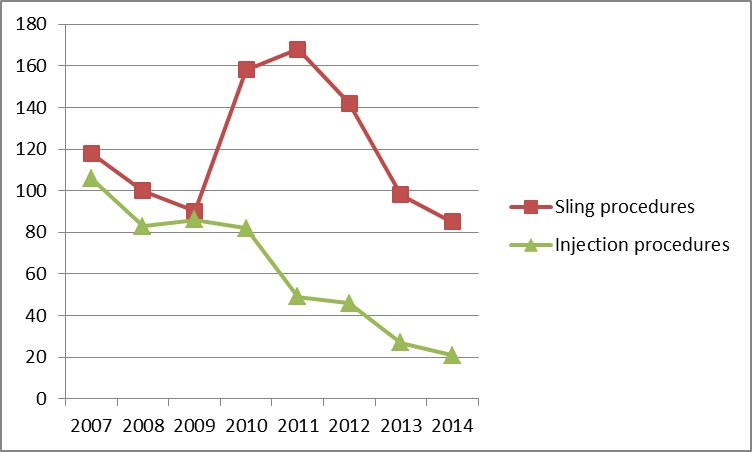|
Back to 2015 Joint Annual Meeting
Changing Practice Patterns For Treatment Of Stress Urinary Incontinence
Casey Kowalik, Arthur P Mourtzinos, Lara S MacLachlan
Lahey Hospital & Medical Center, Burlington, MA
Introduction: In 2008 and 2011, the FDA issued notifications regarding adverse events related to the use of transvaginal mesh. However, the effect of these communications on the use of mesh for stress urinary incontinence (SUI) is unclear. The objective of this study was to examine the changes in surgical treatment of SUI during this period at our institution.
Methods: From 1/1/2007 to 12/31/14, surgical case numbers were collected from billing data using the CPT code for sling operations (57288) and transurethral collagen injections (51715) for the treatment of SUI. Data for revision surgery (53500, 57287) were also collected. Pubovaginal slings performed using autologous fascia were identified by codes 20920, 20922, and 20926.
Results: Over an 8 year period, 959 sling procedures and 500 transurethral injection procedures for SUI were performed. From 2011 to 2014, the utilization of autologous fascia increased from 2.4% to 14.1%. Mesh revision surgery as a percentage of total SUI sling procedures has increased from 6% in 2011 to 21% in 2014. The number of transurethral injection implants has decreased from 106 in 2007 to 21 in 2014 (Figure 1).
Conclusion: Since 2011, there has been a steady decline in the number of procedures performed for SUI, including both slings and transurethral injections. Additionally, the use of autologous fascia pubovaginal slings has increased, as well as the number of mesh revision surgeries.

Back to 2015 Joint Annual Meeting
|

